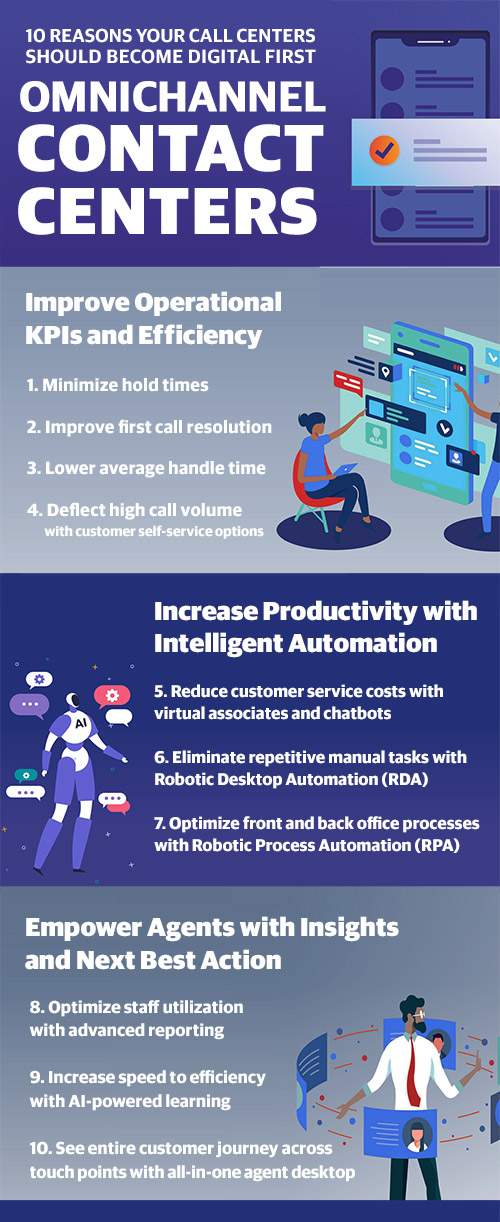Does your business need a call centre or a contact centre? Although these terms are often used interchangeably, there are key differences between these common business communication models. Understanding the difference between a call centre and contact centre, and how they apply to your business needs, is a critical first step to building an efficient, differentiated customer experience that drives loyalty and customer satisfaction.
In this article we put contact centre vs call centre to the test and explain why contact centres are ultimately more beneficial for your company and your customers. We also outline 10 specific reasons your traditional call centres should become digital first omnichannel contact centres, including improvements to operational efficiency such as first contact resolution and average handle time, increases to productivity with intelligent automation to eliminate repetitive tasks, and empowering agents with customer insights and next best action suggestions. But before we can show why contact centres create better customer and employee experiences, it is important to understand what are the differences between a call centre and a contact centre in the first place.
A traditional call centre, as the name suggests, is focused on voice calls. Even if a call centre provides some multi-channel customer service, the interactions are siloed in the individual channels, with no view of the full customer journey. On the other hand, a modern contact centre, as the name indicates, allows customers to contact a company not just via calls, but across whatever channel they choose. Furthermore, a well-designed and managed omnichannel contact centre includes intelligent routing within and across channels so the entire customer journey is visible. This improves customer experience, agent efficiency, and operational KPIs.
1. What is a call centre?
A call centre is a department that services inbound and outbound calls from customers. Traditional call centre agents are customer service representatives who handle customer inquiries, but they may also provide other services such as telemarketing, debt collection, and billing, or other customer-related functions. Call centre operations may be located within an organization or outsourced to a partner that is an expert in the field.
2. What is a contact centre?
A contact centre is a department that handles inbound and outbound customer interactions. Like call centre services, contact centres operate within an organization or may be outsourced to a partner. But unlike call centres, contact centre agents interact with customers across multiple channels, such as messaging, phone, apps, text, email, social media and web.
3. Aren’t contact centres just call centres with more channels?
Historically, inbound call centres were designed to serve as many customers as quickly as possible through one channel: voice calls. In many cases, customers are calling the business as a last resort or they want to speak with someone who can help them directly. Contact centres, in contrast, are designed around the understanding that customers expect fast responses, personalized interactions, and timely results from the channel of their choice. But just adding more channels to a call centre doesn’t make it a contact centre.

A contact centre is the central point from which all customer contacts are managed, which requires the coordination and integration of people, processes, and technology across the business. Contact centre agents, for instance, need to be trained in the best practices of each channel for engaging customers. Performance metrics must also be adapted to each channel to account for different functions and capabilities. A traditional call metric like average handle time, for example, isn’t relevant in mobile messaging.
4. What efficiencies can businesses expect from contact centres?
A company’s ability to meet customer expectations and needs is only as good as the support that it provides.
For example, an outdoor specialty retailer knew its contact centre platform failed to meet its customers’ expectations for efficient answers to product questions and credit card activities. It needed an upgrade to provide more real-time features and avoid wasting its customers’ time. Internally, its basic interactive voice response ivr systems and call distribution weren’t enough. Additionally, staffing issues couldn’t keep up with rising call volume.
We deployed a new Cloud Solution – Cisco® Powered (HCS/CCaaS) for the retailer’s five contact centres and 450 concurrent associates to serve both the credit card and retail customer service operations. New security safeguards were put in place to meet regulations, including automatic caller verification and account escalation protocols.
We also worked on streamlining customer communication interactions. The solution provided callers precision queueing to reach the best possible associate for complex issues, while robust self-service options gave customers control over balance and credit availability inquiries, payments by phone, and even clearing credit holds in the case of suspected fraudulent transactions. Improved outbound collections routing also let delinquent card holders make immediate payments without ever speaking to an associate.
Customers who wanted to speak with an associate could still call to get assistance placing orders, ask billing questions, perform order tracking, or be connected to in-store employees using micro-applications on the associate desktop. Both divisions offered courtesy callbacks, eliminating wait time physically spent on hold. Finally, associates could more easily access backend customer information through soft phones and screen pops, as well as with CRM integration.
The new system routed nearly two-thirds of inbound phone calls to the self-service IVR, with containment (calls sent through the IVR not routed to an associate) approaching the 65 percent mark. First call resolution reached 85 percent, while average handle time improved 34 seconds in the first year for a $675,000 annual savings.
Custom reporting provided detailed information to enable contact centre managers to optimize staff utilization, greatly reducing unproductive time and saving nearly $1 million in the first year, while outbound collections routing saved the client about $1,000 a day. At the end of the first year, the client saw a total cost savings of over $2.5 million, all while improving both the customer and associate experience.
5. Should contact centres be purely automated?
It’s unquestionable that automation technology provides significant cost savings. For every second bots shave off average handle times, contact centres save about $1 million in annual customer service costs and businesses can reduce customer service costs by up to 30 percent by implementing conversational solutions like virtual associates and chatbots.
Automation can, for certain business processes, replace humans (what usually is known as RPA or unattended automation). But there are many things bots can’t do. Bots can’t handle unusual or complex requests. They can’t match a human in expressing empathy. This is why enterprises that have blended automation with humans report that their customer service efforts are more effective at improving both customer satisfaction (61 percent) and associate satisfaction (69 percent).
6. What does the contact centre of the future look like?
Engaging with customers across multiple channels and having the ability to see their behaviors and transactions across different touch points requires organizations to adopt forward-thinking strategies and disciplines. This is why we predict contact centres will evolve into more comprehensive, digital-first customer experience hubs.
Customer experience hubs allow organizations to connect customers’ experiences across the enterprise and engage the omnichannel customer by providing employees with access to the right customer data, at the right time, all in one place and view. As a result, customer care teams will be able to engage customers at the time and via the channel that the customer prefers, with an immense impact on customer satisfaction, customer retention, employee productivity, and overall company profitability.
In the below video, we take a fun look at contact centres vs. call centres, and how customer-centric digital transformation best practices can ensure the contact centre of the future is here sooner than you think.
Call centres vs contact centres: It’s your call
Excellent customer support begins with understanding your customers’ needs and expectations. It’s about systematically and continuously seeking better ways to use technology, data, and operations. So, while traditional call centres serve an essential need of inbound and/or outbound phone calls, are they really meeting your customers’ needs? A more robust customer service contact centre, with seamless omnichannel orchestration across all customer touchpoints, can provide improved CX and operational efficiency.
More resources about omnichannel contact centres
Learn more about how to deliver best-in-class customer experiences with our cloud based contact centre software and contact centre outsourcing solutions. Also, here are additional resources about contact centre digital transformation, automation, and optimization.
Contact Centre of the Future - Digital Transformation Best Practice: A key aspect of successful CX and digital transformation is contact centre transformation in which digital technologies for customer insights, call deflection, personalization, and automation are optimized to turn your old fashioned call centre into a contact centre of the future.
Contact Centre Automation - Tools and Trends: In this article, we explain the most important approach to successful contact centre automation, outline some of the main types of contact centre automation tools being implemented in contact centers, and discuss the benefits of an optimized balance between humans and AI in your CX automation approach
Cloud Contact Centre Solutions to Accelerate Digital Transformation: Cloud contact centres provide many benefits, such as increased flexibility, cost savings, and the ability to support customers from virtually anywhere. As companies move from on-premise to cloud contact centre software, there are new opportunities to identify CX innovation and leverage cloud contact centre best practices to enable value-based transformation. In this trends report, we explore four ways brands are taking advantage of cloud contact centres to spur business growth.




